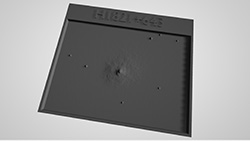CXC Home | Search | Help | Image Use Policy | Latest Images | Privacy | Accessibility | Glossary | Q&A
1
X-ray, Optical, & Radio Images of H1821+643Credit: X-ray: NASA/CXC/Univ. of Cambridge/J. Sisk-Reynés et al.; Radio: NSF/NRAO/VLA; Optical: PanSTARRS
Astronomers have used Chandra to determine the spin of the supermassive black hole in the quasar H1821+643. This is the most massive black hole — which has between 3 and 30 billion solar masses — to have an accurate measurement of this fundamental property. These images of H1821+643 show X-rays from Chandra along with radio data from NSF's Karl G. Jansky Very Large Array and an optical image from the PanSTARRS telescope on Hawaii. The supermassive black hole is located in the bright dot in the center of the radio and X-ray emission. It is spinning about only half as fast as those with a lower mass, giving clues to how it and others like it may have grown and evolved.
2
3D Printable Files: H1821+643 (3D Print Credit: NASA/CXC/A. Jubett, using software by Tactile Universe/N. Bonne & C. Krawczyk & Blender)
This tactile plate depicts the bright glowing quasar H1821+643 powered by a supermassive black hole, as a physical relief map based on the intensity of the X-ray data captured by Chandra. The file for this plate can be downloaded and 3D-printed for learners to touch.
The quasar can be felt at the center of the image and sits in the middle of a hazy cloud. This cloud is hot gas in the cluster of galaxies where the quasar resides, as observed by NASA’s Chandra X-ray Observatory.
The quasar can be felt at the center of the image and sits in the middle of a hazy cloud. This cloud is hot gas in the cluster of galaxies where the quasar resides, as observed by NASA’s Chandra X-ray Observatory.
Return to: Chandra Shows Giant Black Hole Spins Slower Than Its Peers (June 30, 2022)







